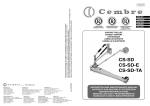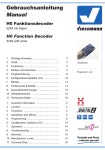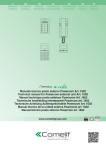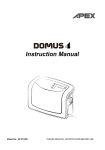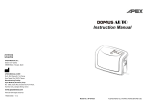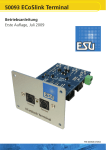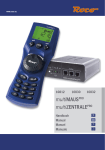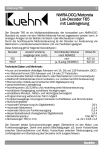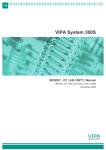Download Bedienungsanleitung - Viessmann Modellspielwaren
Transcript
Gebrauchsanleitung Manual 5301 Booster Eco 4 Belastbarkeit 3,5 Ampere; stapelbar 5301 Booster Eco 4 Power 3.5 ampere 1. Wichtige Hinweise ...................................... 2 2. Einführung / Eigenschaften ........................ 3 3. Anschluss .................................................. 4 4. Konfiguration / Einstellungen ..................... 10 5. Betrieb ........................................................ 11 6. Fehlersuche & Abhilfe ................................ 13 7. Gewährleistung ...................................... 14 8. Umweltschutzhinweis ................................. 16 9. Technische Daten ................................. 16 1. Important Information ................................. 2 2. Introduction / Properties............................... 3 3. Wiring ......................................................... 4 4. Configuration / Setting parameters ............ 10 5. Operation ................................................... 11 6. Troubleshooting .......................................... 13 7. Warranty .................................................... 14 8. Environmental Note .................................... 16 9. Technical Data ............................................ 16 DCC MM DE 1. Wichtige Hinweise EN 1. Important Hints Vor Gebrauch die Sicherheitshinweise und Anleitung genau lesen und beachten! Anleitung und Verpackung aufbewahren. Sie sind Teil des Produktes. Please read this manual carefully and take note of the comments regarding safety PRIOR to using this product! Please keep this manual and the packaging for possible later use. They are part of this product. Sicherer Betrieb Vorsicht: Stromschlaggefahr! Booster und verwendetes Netzteil regelmäßig auf Schäden an Kabeln, Stecker, Gehäuse usw. prüfen. Bei sichtbaren Schäden diese Geräte keinesfalls benutzen! Achtung: Der Booster enthält eine elektronische bzw. mechanische Baugruppe. Er darf nicht geöffnet werden. Setzen Sie den Booster weder Regen, Feuchtigkeit, direkter Sonneneinstrahlung noch staubigem Umfeld aus. Vermeiden Sie starke Temperaturschwankungen. Wenn Sie den Booster aus kaltem Umfeld in warme Räume bringen, sorgen Sie für ausreichende Akklimatisierungszeit von mindestens einer Stunde. Achtung: Betreiben Sie den Booster niemals unbeaufsichtigt. Der Booster ist kein Spielzeug. Stellen Sie sicher, dass er von Kindern unter 15 Jahren nur unter Aufsicht benutzt wird. Weitere Sicherheitshinweise finden Sie im Kapitel Anschluss. Das Produkt richtig verwenden Das Produkt darf ausschließlich dieser Anleitung gemäß verwendet werden. Dieser Digitalverstärker (Booster) ist bestimmt • zum Einbau in Modelleisenbahnanlagen, • zum Anschluss an eine Digitalzentrale (MM oder DCC) an die Anschlüsse CDE, typisch für DCC-Booster oder Märklin-Booster (MM) sowie zusätzlich an LSB (SpeedBus) z.B. an den Viessmann Commander 5300, • zur Versorgung bevorzugt allpolig isolierter Anlagenabschnitte mit digitalem Fahr- bzw. Schaltstrom, • zum Betrieb in trockenen Räumen. Jeder darüber hinausgehende Gebrauch gilt als nicht bestimmungsgemäß. Für daraus resultierende Schäden haftet der Hersteller nicht. Lieferumfang Kontrollieren Sie nach dem Auspacken den Lieferumfang auf Vollständigkeit: 2 Safe operation Attention: Danger of eletric shock! Please check the booster and the mains cable regularly for potential damage to cables, plugs, housing etc. Should there be any visible damage do not use the device until it has been repaired! Attention: The booster contains an electronic respectively a mechanical subassembly. It may not be opened. Never expose the booster to rain, humidity, direct sunlight or a dusty environment. Also avoid strong temperature changes. Make sure you allow the booster sufficient time for acclimatisation of at least one hour if you take it from a cold environment into a heated room. Attention: Never operate the booster unattended. The booster is not a toy. Make sure that is used by children under the age of 15 years only under the supervision of an adult. You will find further safety instructions in the following chapter. Using the product in the right manner This product may only be used according to the instructions stated in this manual. This digital booster is intended for use as follows: • Installation on model train layouts, • For connecting it to digital command station (MM or DCC) to the terminals CDE, typically for DCC boosters or Märklin boosters (MM) as well as to the LSB (SpeedBus) e.g.: to the Viessmann Commander 5300, • For supplying of layout sectors that are preferably insulated in both rails with digital current for running trains and switching accessories, • For operation in dry rooms. Any other use is not considered to be in accordance with regulations. The manufacturer is not liable for any damage that may be caused by inappropriate use. Scope of supply Please check the content of the package regarding completeness: ► Booster 5301 ► Booster 5301, ► Netzteil mit Anschlusskabel ► Power supply unit with mains cable ► 2 grüne Steckverbinder (1x Gleissignal und 1x CDE) ► Two green connectors (1x track output and 1x CDE) ► zwei zusätzliche Gummifüße zur Verwendung beim Stapeln der Gehäuse ► Two additional rubber legs for use when stacking several housings on each other ► diese Anleitung. ► This manual. 2. Einführung / Eigenschaften Booster stellen bei digital gesteuerten Anlagen den benötigten Digitalstrom zur Verfügung. Ihr Einsatz ist immer dann erforderlich, wenn der Strom der Digitalzentrale allein nicht ausreicht, da zu viele Züge und sonstige Verbraucher in Betrieb sind. Als Richtwert kann man davon ausgehen, dass die Zentrale sowie jeder Booster etwa drei bis sechs fahrende Lokomotiven gleichzeitig mit Strom versorgen kann. Zusätzliche Verbraucher wie Waggoninnenbeleuchtungen, Soundmodule oder Weichenantriebe reduzieren diese Zahl. Jeder Booster versorgt einen eigenen Abschnitt der Anlage mit Digitalstrom. Das benötigte Digitalsignal erhält er von der Zentrale, er „verstärkt“ dieses Signal. Es empfiehlt sich, Fahren und Schalten auf verschiedene Booster aufzuteilen, so dass im Störungsfall, z.B. durch Kurzschluss oder Überlastung, nicht die gesamte Anlage stillgelegt wird. Funktionen Der Booster 5301 kann von der Digitalzentrale über die Schnittstellen „Märklin-Booster“ oder „CDE“ mit Digitaldaten versorgt werden und ist geeignet für den Betrieb mit allen handelsüblichen Digitalzentralen der Formate MM und DCC. Die Stromversorgung erfolgt über das mitgelieferte Netzteil. Der optionale Anschluss per LSB (SpeedBus) an den Viessmann Commander ermöglicht die Übertragung von Statusinformationen (z. B. Belastung, Temperatur) und Konfigurationsdaten zwischen Booster und Commander. Die Systemeinstellungen des Boosters erfolgen über den integrierten DIP-Schalter auf der Gehäuserückseite oder über das entsprechende Menü im Commander. Leistungsanzeigen und Fehlermeldungen lassen sich über die LEDs an der Gehäusevorderseite sowie auf dem Commander-Display ablesen. Eine Besonderheit ist, dass die Kurzschlussmeldung an die Zentrale unterdückt werden kann (DIP-Schalter). Dadurch kann verhindert werden, dass bei einem Kurzschluss in einem Anlagenabschnitt die komplette Anlage abgeschaltet wird. 2. Introduction / Properties Boosters supply the required digital current for digitally controlled layouts. They are needed whenever the current supplied by the command station alone is not sufficient to run the trains because there are too many trains running or other electric loads operating. As a rule of thumb one can assume that each command station or booster can run about three to six locomotives simultaneously. Additional electric loads such as coach lighting, sound modules or point motors will reduce this number. Each booster provides energy for its own track section on the layout with digital current. It receives the necessary digital signal from the command station and amplifies it before transmitting it to the track. It is recommended to separate the circuits for running trains and switching accessories. In case of a fault, e.g.: perhaps caused by a short circuit or overload only part of the layout will be out of operation. Functions The booster 5031can be connected to the command station either with the terminals marked „Märklin Booster“ or „CDE“ and then receives the digital signals from the command station. It is suitable for operating with all commercially available command stations supplying the MM or the DCC data format. The power supply is facilitated with the supplied mains unit. The optional connection via the LSB terminals (SpeedBus) to the Viessmann Commander allows the transmission of status information (e.g.: load, temperature) and configuration data between booster and Commander. The system settings are adjusted by means of the integral DIP switches at the back of the housing or via the appropriate menu of the Commander. Display of power and fault messages can be detected by observing the LEDs at the front of the housing as well as on the display of the Commander. The fact that the short circuit feedback to the command station can be suppressed represents a special feature of this booster. This feature can be set with the DIP switch. Thus you can prevent a shutdown of other parts of the layout in case of a short circuit. 3 Datenformate DCC / MM Data formats DCC / MM Der Booster 5301 ist multiprotokollfähig und beherrscht die Digitalformate DCC und Märklin-Motorola (MM). The Booster 5301 is multiprotocol capable and supports the DCC and Märklin Motorola (MM) formats. Der Booster verstärkt das Gleissignal vollständig symmetrisch. Das ermöglicht den Einsatz des ABC-Bremsverfahrens in DCC-Anlagen. Der Booster ist durch Optokoppler vollständig galvanisch von der steuernden Zentrale getrennt. The booster amplifies the track signal fully symmetrically. This allows the use of the ABC braking method in DCC layouts. The booster circuits are completely separated from the command station by means of an optocoupler. Railcom® Railcom® The Booster 5301 is Railcom® capable and provides the so called “Railcom®-Cutout” in the DCC signal. This enables the system to transmit feedback information within this gap from the decoders to the command station. The Railcom® mode of the booster can be turned off, because when operating with command stations that are not Railcom® compatible, a disturbance of the track signal may occur. In pure Märklin Motorola mode the Railcom®Cutout will not cause any potential signal distortion since Railcom® is always switched off in Motorola mode. Der Booster 5301 ist Railcom®-fähig und stellt das sogenannte „Railcom®-Cutout“ im DCC-Signal zur Verfügung. Dies ermöglicht die Übertragung von Rückmeldeinformationen von den Decodern zur Zentrale in der erzeugten Lücke. Der Railcom®-Modus des Boosters ist abschaltbar, da beim Einsatz mit nicht Railcom®-fähigen Zentralen Störungen am Gleissignal auftreten könnten. Bei reinem Märklin-Motorola-Betrieb sind Störungen der Datenübertragung durch das Railcom®-Cutout prinzipiell ausgeschlossen, da es nicht mehr erzeugt wird. Update Der Booster 5301 ist aktualisierbar. Eine neue Version der Gerätesoftware (Firmware) können Sie über den LSB mit Hilfe des Commander jederzeit selbst auf den Booster aufspielen. Nähere Informationen finden Sie jeweils in der Anleitung zum Update. 3. Anschluss Warnung: Alle Anschluss- und Montagearbeiten nur bei abgeschalteter Betriebsspannung durchführen (Ausnahme: LSB-Anschluss)! Verwenden Sie zur Versorgung des Boosters das mitgelieferte Netzteil. Überprüfen Sie Booster und Netzteil regelmäßig auf Beschädigungen an den Kabeln und an den Gehäusen. Offensichtlich beschädigte Teile dürfen Sie keinesfalls verwenden. Nehmen Sie keinesfalls Reparaturversuche selbst vor! Sorgen Sie für ausreichende Belüftung von Netzteil und Booster. Der Einbau in geschlossene Fächer, Schubladen etc. kann zu gefährlichem Wärmestau führen. Überhitzung oder Brände können die Folge sein! 4 Update The booster 5031 is future proof. A new software version (firmware) can be loaded onto the booster via the LSB terminals of the Commander at any time. You will find more detailed information in the manual for the update. 3. Wiring Warning: Any wiring or installation should only be done when the booster is disconnected (exception: LSB connection)! Always use the supplied power supply unit for operating the booster. Regularly check the booster and the mains unit for damage to the cables or the housing. Obviously damaged parts may not be used for service under any circumstances. Never attempt to repair the unit yourself! Make sure there is sufficient ventilation for both the power supply unit and the booster. Installing the devices in enclosures such as shelves, drawers etc. may lead to a dangerous heat build-up. Overheating or even fire could be the result! Zum Anschluss des Boosters an die Digitalzentrale Ihrer Modellbahn sowie die Gleisabschnitte beachten Sie bitte die unten stehenden Hinweise und Zeichnungen. Schließen Sie den Booster gemäß der folgenden Abbildungen an. Always observe the hints and drawings given in this manual when connecting the booster to the command station as well as the track sectors of your model train layout. Wire the booster according to the following figures. Übersicht über Geräteanschlüsse Connections overview Netzteil Eingang CDE (DCC) power supply 2x Eingang / input input CDE (DCC) Märklin Booster Hauptgleisausgang Fig. 1 (durchgeschleift / looped) track output 2x LSB (geschleift) (looped) Abb. 1 Grundlagen Boosteranschluss am Gleis (Versorgungsabschnitte) Achtung: Es ist immer darauf zu achten, dass die Ausgänge von Zentralen und Boostern gleichsinnig an den Gleisen angeschlossen werden. Die Ausgänge „B“ und „0“ müssen also immer an derselben Gleisseite liegen, bzw. an Mittelleiter und Schiene. Basics: Connecting the booster to the track (track power sections) Attention: Please make sure that the outputs of the command station and boosters are always connected to the same side of the tracks. The outputs “B” and “0” must always be wired to the same rail (always to the right rail or always to the left rail) respectively to the centre contacts and the tracks. Stromversorgung / Netzteil Power supply unit Hinweis: Note: The power supply unit of the booster is current controlled and will automatically switch off in case of excessive current and back on again after a certain time. Das Netzteil des Boosters ist strombegrenzt und schaltet sich bei Überstrom selbstständig aus und nach einer gewissen Zeit wieder ein. Digitalzentrale Sie können den Booster entweder über die CDEBuchse oder die MBooster-Anschlüsse mit dem Gleissignal versorgen. Wenn beide Signale zur Verfügung stehen, dann empfehlen wir die Verwendung des CDE-Signals. Digital command station You can supply the track signal to the booster either via the CDE sockets or the MBooster sockets. If both signals are available then we recommend to use the CDE signal. DCC: (see Figure 2 on page 6) DCC: (Abbildung 2 auf Seite 6) MM: (see Figure 3 on page 6) MM: (Abbildung 3 auf Seite 6) Commander: (see Figure 4 on page 7) Commander: (Abbildung 4 auf Seite 7) Note: If you use another command station and not the Viessmann Commander then the “LSB” cable is omitted. Hinweis: Falls Sie eine andere Zentrale als den Viessmann Commander verwenden, entfällt die Leitung „LSB“. 5 Abb. 2 Dreileitergleise: rot = Mittelleiter Three-rail-tracks: red = center rail allpolige Trennung empfohlen / complete isolation recommended Hauptgleis / Main track braun brown rot red braun brown CDE Für alle DCC- und MM-Zentralen geeignet! 230 V ~ AC Suitable for all DCC and MM digital command stations! 5301 Booster Abb. 3 rot red Anschluss / Connection CDE / Märklin-Booster Power supply Netzteil zum Hauptgleisanschluss to main track plug Dreileitergleise: rot = Mittelleiter Three-rail-tracks: red = center rail DCCZentrale DCCZentrale DCCZentrale allpolige Trennung empfohlen / complete isolation recommended Hauptgleis / Main track braun brown rot red braun brown zum Hauptgleisanschluss to main track plug rot red Netzteil Power supply Anschluss / Connection CDE / Märklin-Booster MM-Booster Für alle DCC- und MM-Zentralen geeignet! 230 V ~ AC 6 Fig. 2 5301 Booster Suitable for all DCC and MM digital command stations! MärklinMotorolaZentrale DCCZentrale DCCZentrale Fig. 3 Abb. 4 Dreileitergleise: rot = Mittelleiter Three-rail-tracks: red = center rail allpolige Trennung empfohlen / complete isolation recommended Hauptgleis / Main track braun brown rot red braun brown zum Hauptgleisanschluss to main track plug Fig. 4 rot red Netzteil Power supply Anschluss / Connection CDE / Märklin-Booster CDE LSB optional 230 V ~ AC Commander 5301 Booster Mehrere Booster anschließen Sie können Ihre Anlage zur Erhöhung der Betriebssicherheit in mehrere Versorgungsabschnitte aufteilen. Jeder Abschnitt wird dabei von einem eigenen Booster mit Strom versorgt. Es ist sinnvoll, die Anlage mit gleichen Boostern zu versorgen. Teilen Sie Ihre Anlage dazu in einzelne, elektrisch voneinander getrennte Abschnitte auf, die Sie jeweils mit einem eigenen Booster versorgen. In jedem Versorgungsabschnitt sollten sich durchschnittlich max. ca. vier fahrende Züge / Loks befinden. Ordnen Sie die Übergänge zwischen den Versorgungsabschnitten so an, dass diese möglichst selten überfahren werden. Wir empfehlen, die Übergänge zwischen den Booster-Abschnitten stets vollständig (Zweileiter: beide Schienen; Dreileiter: stromführende Schienen und Mittelleiter) zu trennen. Anderenfalls sind Verschlechterungen der Signalqualität möglich. Dies ist auch möglich, sobald Fahrzeuge die Trennstelle überbrücken. Daher sollten auch keinesfalls abgestellte Fahrzeuge diese Trennstellen dauerhaft überbrücken. Teilen Sie Fahren und Schalten auf. Verwenden Sie beispielsweise den Gleisausgang Ihrer Zentrale zur Versorgung der ortsfesten Schaltgeräte (Decoder) auf der Anlage. Zur Versorgung der z. B. Commander e. g. Commander Connecting several boosters For increased reliability you can subdivide your layout into several supply sectors. Each sector is then supplied with power from its own booster. It is recommended to use the same type of booster for the entire layout. Subdivide your layout into individual, electrically isolated sectors to be wired to one booster each. On average there should be no more than about four trains or locomotives running in each sector. Locate the insulation gaps between the sectors in such a ways that they are not crossed very often. We recommend insulating both conductors between the booster sectors (standard DC resp. DCC arrangement: insulate both rails; three-rail system: insulate the centre conductor and the rails). Insulating only one side may lead to a reduced signal quality. Lower signal quality may also be present whenever a vehicle crosses the insulating gaps. Therefore no vehicle should be “parked” for longer periods while standing across the gaps. Subdivide the circuits for running trains and switching accessories. For instance, use the track output of your command station for controlling stationary decoders for accessories and use separate boosters for your track sectors. Connecting several boosters: CDE: Wire the conductors of the sockets parallel and also connect them to the next booster. Märklin: Both sockets of the booster are through 7 Abb. 5 Fig. 5 DIP-Nr. Funktion / function 1 Reset / Reset 2 Railcom® / RailCom Cut-out is switched on/off 3 Nicht benutzt / not in use 4+5 Einstellung der Ausgangsspannung / Adjusting the output voltage 6+7 Einstellung der Ausgangsstroms u. d. Reaktion auf Überlast / Adjusting the output current and the response to overload 8 WnP Ein / On ON 1 2 3 4 5 6 7 8 Aus / Off DIP-Schalter DIP-Switch Kurzschlussmeldung an Zentrale report short circuit / Transmit short circuit indication to the command station Einstellung des Ausgangsstroms und der Reaktion auf Überlast: S6 S7 on on Adjusting the output current and the response to overload: Wert / Reaktion Value / Response on voller Strom (3,5 A), schnell full current (ca. 3.5 A), fast response off mittlerer Strom (2,7 A), schnell medium current (ca. 2.7 A), fast response off on kleiner Strom (2 A), schnell low current (ca. 2 A), fast response off off voller Strom (3,7 A), langsam full current (ca. 3.7 A), slow response Einstellung der Ausgangsspannung: Adjusting the output voltage: S4 S5 Wert / Reaktion Value / Response on on ca. 18,5 V Approx. 18.5 V on off ca. 17 V Approx. 17 V off on ca. 15 V Approx. 15 V off off ca. 13 V Approx. 13 V Abb. 6 Fig. 6 1 3 2 8 LED: 1 - 4: grün / green 5: gelb / yellow 6: rot / red 4 5 6 Abb. 7 Anzeige der Betriebsbereitschaft / Kurzschluss / Fehlerzusände mit LEDs Linke grüne LED blinkt langsam Gleisspannung eingeschaltet und keine nennenswerte Stromabgabe, d. h. kleiner als 300 mA (= Bereitschaftsanzeige) Leuchten mehrerer grüner LEDs in einer Reihe Maß für die aktuelle Leistungsabgabe (v.l.n.r.) Leuchten nur der roten LED Kurzschluss an diesem Boosterausgang; Booster abgeschaltet Leuchten der linken grünen LED und der roten LED Kein Signal von der Zentrale vorhanden; Zentrale nicht eingeschaltet oder wegen Kurzschluss ausgeschaltet Leuchten der roten und gelben LED Temperatur zu hoch; Booster überhitzt und abgeschaltet Leuchten der linken grünen LED und der gelben und roten LED Spannung zu hoch; entweder ist die Versorgungspannung zu hoch oder es liegt eine hohe Fremdspannung am Gleis Blinken der dritten grünen LED (v.l.n.r.) Booster befindet sich im Update-Modus Fig. 7 Indicating readiness for service / short circuit / faults with LEDs The left green LED blinks slowly If several LEDs light up in a row, for instance form left to right Track voltage is turned on and there is (virtually) no current flowing, that is, the current is less than 300 mA (= indication of readiness for service) this is a measure for the current power consumed Only the red LED lights up short circuit on this booster output; Booster is switched off The green and the red LED light up there is no signal from the command station; the command station is not switched on or has shutdown due to short circuit The red and the yellow LED light up the temperature is too high; Booster is overheating and has switched off The left green LED and the yellow and red LED are light up the voltage is too high; either due to the fact the supply voltage is too high or there is a high voltage from another source applied to the tracks The third green LED (from left to right) is blinking this indicates that the booster is in the update mode 9 verschiedenen Fahrstrombereiche können Sie dann einen oder mehrere Booster nutzen. Nenngröße Scale empfohlene Gleisspannung recommended track voltage CDE: Die Leitungen an den Buchsen parallel schalten und jeweils zum nächsten Booster weiterleiten. Z 12 V N / TT 14 V H0 16 - 18 V Märklin: Die beiden Buchsen am Booster sind durchgeschleift. Es spielt also keine Rolle, welches Kabel zur Zentrale führt und welches zum jeweils nächsten Booster. Tipp: Wenn Sie mehrere Booster übereinander stellen wollen, so können Sie die hinteren Gehäusefüße gegen die höheren austauschen. So stehen die Geräte im erforderlichen Abstand und parallel zueinander. Beachten Sie, dass diese Aufstellweise die Kühlung geringfügig beeinträchtigen kann. 4. Konfiguration / Einstellungen Die Einstellung des Boosters erfolgt entweder über den DIP-Schalter auf der Gehäuserückseite oder über das entsprechende Menü des Commanders. Konfigurationsbefehle des Commanders haben gegenüber dem DIP-Schalter immer Vorrang. Wenn der LSB-Anschluss zu einem Commander hergestellt wurde, so sendet der Commander bei entsprechender Software-Version die Information zur Einstellung des Boosters – die Schalterstellungen werden nicht mehr beachtet! Wenn kein LSB-Anschluss verwendet wird, z.B. bei Verwendung einer anderen Digitalzentrale, so werden automatisch die Schalterstellungen zur Konfiguration verwendet. Dies gilt auch, wenn Sie den Booster vom LSB getrennt haben und danach die Stellung des Schalters verändern: Ab sofort werden die neuen Stellungen wirksam. Vor Inbetriebnahme des Boosters am Gleis sollten Sie die Ausgangsspannung auf den für Ihre Baugröße passenden Wert einstellen. Idealerweise stellen Sie die Digitalzentrale und weitere Booster auf denselben Wert ein. Einstellungen über Commander Die folgenden Parameter lassen sich über den Commander einstellen: •Ausgangsstrom: gestuft bis 3,5 A •Ausgangsspannung: gestuft von 13 bis 18,5 V •Weitere Betriebseigenschaften Hinweise zur Bedienung der Commander-Menüs erhalten Sie im Referenzhandbuch des Commanders. 10 wired. Therefore it does not matter which cable leads to the central unit and which goes to the next booster. Hint: If you want to place several boosters on top of each other then you may exchange the back legs against higher ones, which are supplied with the device. Thus the devices will have the right spacing between them and are parallel to each other. Please bear in mind, that this type of arrangement may reduce the cooling to a certain degree. 4. Configuration / Setting parameters The setting of the booster can either be done with the aid of the DIP switches at the back of the housing or via the appropriate menu of the Commander. Configuration commands issued by the Commander will always get preference over the setting of the DIP switches. Once the connection to the LSB sockets of the Commander have been made, the Commander will transmit the signals for setting the booster and the position of the DIP switches will be ignored! This process only works provided the appropriate software (firmware) version is available. If the LSB connection is not used when you for instance connect to another type of command station then the DIP switches will automatically have priority for configuring the booster. This is also true in case you have disconnected the booster form the LSAB sockets and subsequently have changed the setting of a switch: the new settings will be effective immediately. Prior to connecting the booster to the tracks you should set the track voltage to the appropriate value suitable for your type of trains (scale). Ideally you will set the command station and all boosters to the same output value. Setting with the Commander You can adjust the following parameters with the Commander: •Output current: in steps up to 3.5 A •Output voltage: in steps from 13 to 18.5 V •Other operating characteristics You will find hints regarding working with the menus of the Commander in the reference handbook for the Commander. Einstellungen über DIP-Schalter (siehe Abb. 5) Die folgenden Parameter lassen sich über den DIP-Schalter einstellen: S8 on: Kurzschlussmeldung an Zentrale senden S3: nicht benutzt S2 on: Railcom®-Cutout eingeschaltet S1 on/off: Programmierschalter: Löschen der LSB-Adrdesse. Zum Löschen der LSB-Adresse betätigen Sie bitte den Reset-Schalter innerhalb von 2 Sekunden von der Stellung „on“ auf „off“ und wieder zurück. Die LSB-Busadresse wird dann gelöscht und das Gerät meldet sich neu am Commander an. Bitte beachten Sie, dass die Schalterstellungen auch während des Betriebs des Boosters eingelesen werden. Änderungen werden also sofort gültig. Werkeinstellungen Setting parameters with DIP switches (see Fig 5.) The following parameters can be adjusted with the DIP switches: S8 on: Transmit short circuit indication to the command station S3: not in use S2 on: Railcom® Cut-out is switched on S1 on/off: Programming switch: Deleting the LSB address If you wish to delete the LSB address simply toggle the reset button between “On” and “Off” within two seconds. Then the LSB bus address will be deleted and the device will register once again at the Commander. Please note that the switch positions can be read out even during operation of the booster. Any changes will be effective immediately. Sonstige Parameter: Railcom®-Cutout eingeschaltet; Kurzschlussmeldung an Zentrale eingeschaltet. Factory default settings Without the LSB (SpeedBus) the booster is configured according to the positions of the DIP switches. Ex works all switches are in the “Up” position. If the LSB is connected to the Commander, then the configuration commands issued by the Commander have priority over those from the DIP switches. Electrical outputs values ex works: 18.5 V; 3.5 A; Other parameters: Railcom® Cut-out is switched on; short circuit report to command station is active. 5. Betrieb 5. Operation Displayanzeigen Status displays Die LEDs an der Vorderseite des Boosters zeigen den aktuellen Betriebszustand an. The LEDs at the front of the booster show the current operational status. Beim Start des Boosters (Energieversorgung herstellen) leuchten nacheinander als Leuchtentest alle LEDs auf, bis alle an sind. Danach zeigen die LEDs den aktuellen Betriebszustand. When starting the booster (power on) all LEDs light up in sequence for testing until they are all lit. After that the LEDs show the current status. Anzeige der Betriebsbereitschaft / Kurzschluss / Fehlerzustände mit LEDs (siehe Abb. 6 + 7): Indicating readiness for service / short circuit / faults with LEDs (see Fig. 6 + 7): Ohne LSB (SpeedBus) gelten die Einstellungen am DIP-Schalter. Ab Werk : Alle Schalter oben. Wenn per LSB ein Commander angeschlossen ist, haben dessen Konfigurationsbefehle Vorrang vor dem DIP-Schalter. Elektrische Ausgangswerte ab Werk: 18,5 V; 3,5 A; Anzeige der Belastung Es gelten in etwa die folgenden Zusammenhänge: • linke grüne LED leuchtet: Strom > ca. 300mA (ca. 320 / 170 mA) • zwei grüne LEDs leuchten: Strom > ca. 700 mA (ca. 540 / 400 mA) • drei grüne LEDs leuchten: Strom > ca. 1200 mA (ca. 930 / 700 mA) • vier grüne LEDs leuchten: Strom > ca. 1900 mA (ca. 1500 / 1100 mA) Indicating the load Below we list the indications regarding the current: • Left green LED lights up: current > ca. 300mA (ca. 320 / 170 mA) • Two green LEDs light up: current > ca. 700 mA (ca. 540 / 400 mA) • Three green LEDs light up: current > ca. 1200 mA (ca. 930 / 700 mA) • Four green LEDs light up: current > ca. 1900 mA (ca. 1500 / 1100 mA) 11 • grüne LEDs und gelbe LED leuchten: Strom > ca. 2700 mA (ca. 2100 / 1500 mA) • grüne und gelbe LEDs leuchten, rote LED blitzt länger auf : Strom > ca. 3200 mA (ca. 2500 / 1800 mA) • grüne, gelbe und rote LEDs leuchten : Strom > ca. 3400 mA, nahezu Überlast erreicht (ca. 2600 / 1950 mA) (Werte in Klammern geben die Ströme an, die in etwa bei reduzierter Stromabgabe gelten.) Die Anzeige der Ströme auf dem Commander erfolgt analog zu dieser Tabelle. Außerdem gibt die Commanderanzeige eine Information über die Betriebstemperatur des Boosters. Das Feld neben der Belastungsskala zeigt die Nummer des Boosters und die Temperaturstufen 50, 70 und 80 Grad C an. Bei mehr als 85 Grad C schaltet der Booster ab. Nach Abkühlung unter diesen Wert schaltet er wieder ein. Einschalten / Ausschalten Der Booster schaltet sich selbst ein, sobald von der angeschlossenen Zentrale über CDE oder Märklin-Booster ein Steuersignal anliegt. Wenn kein Steuersignal seitens der Zentrale anliegt oder im Fehlerfall ist die Endstufe des Boosters ausgeschaltet. Kurzschluss Der Booster schaltet sich bei Kurzschluss nach ca 0,5 bis 1,5 Sekunden (abhängig von der Art der Überlastung und der Temperatur) selbstständig ab. Gleichzeitig sendet der Booster eine Kurzschlussmeldung an die steuernde Zentrale und löst dort den Stop der Anlage aus. Es ist jedoch nicht immer erwünscht, dass wegen eines einzelnen überlasteten Stromkreises die ganze Anlage abgestellt wird. Falls Sie dies nicht wünschen, können Sie per DIP-Schalter auswählen, dass der Booster die Meldung nicht über die Hardware-Schnittstelle CDE (Leitung E) bzw. Märklin-Booster meldet. Er versucht dann nach ca. 3 bis 5 Sekunden (abhängig von der Temperatur) den Neustart. Leistung / Auslastung Der Booster liefert eine Dauerausgangsleistung von bis zu 65 VA (3,5 A bei 18,5 V). Kurzzeitig kann der Booster einen Spitzenstrom von 4 A liefern. Die aktuelle Belastung zeigt der Booster auf dem LED-Display (siehe Abb 7) sowie auf dem Commander-Bildschirm an. 12 • All green LEDs and the yellow LED light up: current > ca. 2700 mA (ca. 2100 / 1500 mA) • Green and yellow LEDs light up, and the red LED flashes for a bit : current > ca. 3200 mA (ca. 2500 / 1800 mA) • Green, yellow and red LEDs light up : current > ca. 3400 mA, almost overload (ca. 2600 / 1950 mA) (The values in brackets show the approximate currents that are supplied when the current is reduced.) The display of currents on the Commander follows the principle of this table. The Commander also provides information regarding the operating temperature of the booster. The field next the load scale shows the number of the booster and the temperature steps 50, 70 and 80 degrees C. If the temperature reaches 85 degrees C, the booster will switch itself of. Once the booster has cooled off it will automatically switch on again. Switching on / off The booster switches itself on as soon as a signal from the command station is available (either via CDE or the Märklin booster). If there is no signal from the command station or in case of an fault the output stage of the booster is switched off. Short circuit In case of a short circuit the booster automatically switches off after about 0.5 to 1.5 seconds (subject to the type of overload and the temperature). At the same time the booster transmits a signal reporting the short circuit to the command station and triggers the STOP function of the command station. However, it is not always desirable to turn off the entire layout due to one single overloaded circuit. If you do not want the booster to send this short circuit report to the command station via the CDE cable (conductor E) respectively the Märklin booster, you can set this by means of the DIP switches. In this case the booster will attempt to start again after about 3 to 5 seconds (subject to the temperature). Power / workload The booster provides a continuous power of up to 65 VA (3.5 A at 18.5 V). the maximum short term current is 4 A. The booster indicates the current load on the LED display (also refer to the table describing the display indications) as well as on the monitor of the Commander. Beachten Sie, dass ein Herabsetzen der Ausgangsspannung zu vermehrter Hitzeentwicklung im Gehäuse führt. Dies kann zu temperaturbedingtem Abschalten führen. Please note that reducing the output voltage may lead to increased heat load inside the housing. This may lead to automatic shutdown due to high temperature. 6. Fehlersuche und Abhilfe 6. Troubleshooting Jedes Viessmann-Produkt wird unter hohen Qualitätsstandards gefertigt und vor seiner Auslieferung geprüft. Sollte es dennoch zu einer Störung kommen, prüfen Sie bitte als erstes die Stromzufuhr und die Verkabelung. Each Viessmann product is manufacture according to stringent quality standards and is tested prior to delivery. Should a fault occur despite these measures first check the power supply and the wiring. Wenn Sie die Fehlerursache nicht finden können, geben Sie den Booster in der zugehörigen Verpackung inkl. Netzteil zu Ihrem Fachhändler oder senden Sie ihn zur Reparatur bitte direkt an den Viessmann-Service (Adresse siehe unten). Should you not be able to find the cause of the fault put the booster in its original packaging including the power supply unit and return it to your dealer or hobby shop or send it directly to the Viessmann service department (see below for the address). 1) Der Booster wird ungewöhlich heiß ohne Fehlermeldung. Trennen Sie sofort die Verbindung zur Versorgungsspannung! 1) The booster gets unusually hot without an error message Disconnect the power supply immediately! Mögliche Ursache: Zu wenig Kühlung oder Defekt am Booster. Potential cause: insufficient cooling or defect booster. 2) Die LEDs am Booster leuchten nicht und die Loks lassen sich nicht ansteuern. 2) The LEDs on the booster do not light up and the locos cannot be controlled anymore. Mögliche Ursache: Die Spannungsversorgung ist unterbrochen. Potential cause: The power supply is interrupted. Überprüfen Sie die Anschlüsse an die Spannungsversorgung (Netzteil, Netzsteckdose). Check the connections to the power supply unit (on the device and also the mains plug and wall outlet). 3) Die rote LED sowie oder mehrere weitere LEDs leuchten und die Loks lassen sich nicht ansteuern. 3) The red LED as well as several other LEDs light up and the locos cannot be controlled anymore. Ursache: Der Booster hat einen Fehlerzustand erkannt. Prüfen Sie die Art des Fehlers anhand des Absatzes „Displayanzeigen“. Cause: The booster has detected a fault. Check which type of fault it is as described in the chapter „Indicating faults“. Beispiel: Der Booster schaltet ab. Die rote sowie die gelbe LED leuchten. Example: The booster switches off. The red as well as the yellow LED light up Mögliche Ursache: Der Booster wird nicht ausreichend belüftet und hat sich überhitzt. Potential cause: The booster is not sufficiently ventilated and is overheated. Sorgen Sie dafür, dass über die Lüftungsschlitze auf der Ober- und der Rückseite des Boosters ein ungehinderter Luftaustausch möglich ist. Mögliche Ursache dafür: Die eingestellte Gleisspannung ist auf einen sehr niedrigen Wert eingestellt. Die Leistung, die aus der Differenz zwischen der tatsächlichen Netzteilspannung und der gewünschten Gleisspannung und dem entnommenen Strom entsteht, muss vom Booster als Wärme abgeführt werden. Ist diese Leistung zu hoch, überhitzt der Booster und schaltet infolge Übertemperatur ab. Make sure that the ventilation slots at the top and the back of the booster facilitate an unimpaired air flow. Potential cause for this: the set track voltage is adjusted to a very low value. The power corresponding to the difference between the actual voltage supplied by the power supply unit and the desired track voltage has to be converted into heat by the booster. If this power is too much, then the booster overheats and automatically is turned off due to high temperature. 13 7. Gewährleistung 7. Warranty Jedes Produkt wird vor seiner Auslieferung auf vollständige Funktion überprüft. Der Gewährleistungszeitraum beträgt 2 Jahre ab Kaufdatum. Tritt in dieser Zeit ein Fehler auf, setzen Sie sich bitte direkt mit der Firma Viessmann Modellspielwaren in Verbindung. Wird nach Überprüfung des Modells ein Herstell- oder Materialfehler festgestellt, wird das Produkt kostenlos instandgesetzt. Each product undergoes a full function test prior to delivery. The warranty period is two years from date of purchase. Should there be a fault during this period, please contact Viessmann Modellspielwaren directly. If we find a manufacturing or material fault after checking the product, then we will repair the product free of charge. Von der Gewährleistung ausgeschlossen sind Beschädigungen des Modells, die durch unsachgemäße Behandlung, Nichtbeachten der Bedienungsanleitung, nicht bestimmungsgemäßen Gebrauch, Überlastung, unzulässig hoher Umschaltimpuls von analogen Wechselstromanlagen, fehlerhafte Verdrahtung der Modellbahnanlage, eigenmächtigen Eingriff, bauliche Veränderungen, Gewalteinwirkung, Überhitzung u. ä. verursacht werden. Jede Haftung für Schäden und Folgeschäden durch nicht bestimmungsgemäßen Gebrauch, Nichtbeachtung der Bedienungsanleitung, eigenmächtigen Eingriff, bauliche Veränderungen, Gewalteinwirkung, Überhitzung, Überlastung, Feuchtigkeitseinwirkung u. ä. ist ausgeschlossen. Wenn Sie die Fehlerursache nicht finden können, senden Sie das Modell zur Reparatur bitte direkt an den Viessmann-Service (Adresse siehe unten). 14 From the warranty excluded are damaged products due to inappropriate handling or use, ignoring the user manual, overload, not permitted high switching pulses in analogue AC layouts, faulty wiring of the model train layout, unauthorised changes to the product, effects caused by undue force, overheating and similar causes. If you cannot establish the cause of the fault, send this model for repair directly to the Viessmann Service (address see below). Notizen Notes 15 8. Umweltschutzhinweis 8. Environmental Note Dieses Produkt darf am Ende seiner Lebensdauer nicht über den normalen Hausmüll entsorgt werden. Es muss an einem Sammelpunkt für das Recycling von elektrischen und elektronischen Geräten abgegeben werden. Das Mülleimer-Symbol auf dem Produkt, der Bedienungsanleitung oder der Verpackung weist darauf hin. Die Werkstoffe sind gemäß ihrer Kennzeichnung wiederverwertbar. This product may not be disposed of in normal household garbage at the end of its life. It must be dropped off at a collection station for recycling of electrical and electronic devices. The symbol showing the trash can on the product, the user manual and the packing point this out. The materials can be reused according to their identification. 9. Technische Daten Maße: 150 x 108 x 45 mm Gewicht: 225 g Anschlüsse: •1 Power 2,5 mm Hohlstecker-Buchse für 18 V DC (Commander-Netzteil) •1 Gleisausgang •1 CDE für DCC-Booster (isoliert) •2 Märklin Booster (durchgeschleift, isoliert) •2 LSB für Commander (durchgeschleift, isoliert) Betriebsspannung: 19 V Betriebsstrom: max.: 4,5 A Digitalsysteme: DCC / MM Schutzklasse / Isolation: IP 30 Railcom®-Cutout: ja, einstellbar Temperatur / rel. Feuchtigkeit (Betrieb): +8 - +40 °C / max. 85 % nicht betauend. Temperatur / rel. Feuchtigkeit (Lagerung): 0 – 60 °C / max. 85 % nicht betauend. Der Booster wurde gemäß den Anforderungen der EG-Richtlinie 2004/108/EG über die elektromagnetische Verträglichkeit entwickelt und trägt die entsprechende CE-Kennzeichnung. 9. Technical Data Dimensions: 150 x 108 x 45 mm Weight: 225 g Connections: •1 Power 2.5 mm hollow plug-socket for 18 V DC (Commander power supply unit) •1 Track output •1 CDE for DCC booster (isolated) •2 Märklin booster (through wired, isolated) •2 LSB for Commander (through wired, isolated) Operating voltage: 19 V Operating current: max. 4.5 A Digital systems: DCC / MM Protection class / degree of protection: IP 30 Railcom® Cut-out: yes, adjustable Temperature / rel. humidity (during operation): +8 - +40 °C / max. 85 % not bedewed. Temperature / rel. humidity (storage): 0 – 60 °C / max. 85 % not bedewed. The booster was developed in accordance with the EG directive 2004/108/EG regarding electromagnetic compatibility and bears the appropriate CE mark. RailCom® ist ein eingetragenes Warenzeichen der / is a registered trademark of Lenz-Elektronik GmbH, Gießen. Märklin ist ein eingetragenes Warenzeichen der / is a registered trademark of Gebr. Märklin & Cie GmbH, Göppingen. Motorola ist ein eingetragenes Warenzeichen der / is a registered trademark of Motorola Inc., Tempe-Phoenix / Arizona (USA). Weitere Produkt- oder Firmennamen können Marken oder Handelsnamen ihrer jeweiligen Inhaber sein. Modellbauartikel, kein Spielzeug! Nicht geeignet für Kinder unter 14 Jahren! Die Anschlussdrähte niemals in eine Steckdose einführen! Anleitung aufbewahren! Modelbouwartikel, geen speelgoed! Niet geschikt voor kinderen onder 14 jaar! De aansluitdraden nooit in een wandcontactdoos steken! Gebruiksaanwijzing bewaren! Model building item, not a toy! Not suitable for children under 14 years! Never put the connecting wires into a power socket! Keep these instructions! Articolo di modellismo, non è un giocattolo! Non adatto a bambini al di sotto dei 14 anni! Non inserire mai i fili di collegamento in una presa! Conservare instruzioni per l’uso! Ceci n’est pas un jouet. Ne convient pas aux enfants de moins de 14 ans ! Ne jamais introduire les fils d’alimentation dans une prise! Conservez ce mode d’emploi ! Artículo para modelismo ¡No es un juguete! No recomendado para menores de 14 años! ¡No introducir nunca los hilos de conexiones en un enchufe de la red eléctrica! Conserva las instrucciones de servicio! Modellspielwaren GmbH 92343 Stand 01 11/2012 TB



















